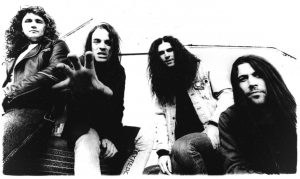 In the autumn of 2016, I got a Facebook message from a headbanger in Moscow (Russia, not Idaho!) asking some questions about Panic. In itself, this was not unusual. Once every few months I hear from someone asking about the band. I figure it’s easiest to track me because I have an uncommon name…
In the autumn of 2016, I got a Facebook message from a headbanger in Moscow (Russia, not Idaho!) asking some questions about Panic. In itself, this was not unusual. Once every few months I hear from someone asking about the band. I figure it’s easiest to track me because I have an uncommon name…
Konstantin Chilikin has an on-line metal magazine called Stay Heavy and wondered if I’d agree to an interview. I said of course, and gave him my email address to send the questions.
What he sent was the most-exhaustive list of prompts I’d ever seen. How this guy from the other side of the world could even know about some of the shit was beyond me. It sounded like he was writing from Burien! For a second, I actually thought it might be someone from within the Circle of Trust playing an internet prank on me– because some of this stuff bordered on inside jokes. And it’s not like this guy has just been sitting in his parents’ basement in Moscow obsessing on Panic since the 1990s. He’s clearly one of these guys who enjoys research, and he has accumulated this level of knowledge about hundreds if not thousands of American metal bands from the last 30 years.
I was pretty overwhelmed at first, and hastily shut down the email– trying to forget about it. Occasionally I’d open it back up and eventually I started pecking away at it. More than a year later, I’d finished what had become an 10,000 word history of the band, using Konstantin’s questions as an outline. It was actually a real gas to write, with lots of trips down memory alley and more than a few fact-checking sidetrips. It’s fun to research yourself– you can find out some stuff you’d forgotten.
Anyway, it’s far from ‘complete’ but it is accurate. Also, it is not for everyone. I’d say for completists only. Some of you will find yourselves in here. A few of you might not find the light in which history has recalled you to be very flattering, in which case maybe you shouldn’t have been such a fuckin’ dick at the time. History aint pretty…
In order to keep as much of your attention as possible, I’ll break this into three movements. I’ll add Konstantin’s prompts at the top of each section for context. Jack, George & Marty have already read this and issued their fondest endorsements. I hope you like it, too, although truthfully I don’t really expect you to read it…
Stay heavy,
–Braimes
Well, Jeff, let’s imagine we have a time machine and now we are ready to jump in the past. Location: Seattle, Year: 1987. Ronald Reagan is still in the White House, Starbucks still is a local company, Def Leppard has released “Hysteria”, while Guns ‘n Roses have unleashed “Appetite For Destruction”, “Slippery When Wet” is the most selling album in the USA and Nirvana is doing its first steps. And what about you and your band mates? What were you doing in 1987?
What about music scene in Seattle in the late 80’s? For many people this city is the cradle of Grunge but was there any interest in heavy metal? Were you close with guys from Forced Entry, The Accused and Sanctuary? Were you influenced by local heavy metal heroes Culprit? Did you have any troubles with hardcore / indie bands like The Melvins, Beat Happening etc.?
Tell me about the very early days of Panic. What influenced you to get in touch with other guys and form a band? What can you say about your first demo from 1988? Was it any good? Would you play it to your children nowadays?
I won’t bother you with questions about each demo but can you say a few words about that demo-era of Panic in general? Was it flooded with live gigs, new friends, business contacts, parties and whatever or was it pretty steady?
Summer of 1987
First of all, Konsantin, thanks for this very comprehensive questionnaire! Your perception of what it was like to be a PacificNorthWestern American headbanger in this particular era is very keen!
Panic was two years old and transitioning from the name Cold Steele at this point in time. We were experiencing something of an identity crisis, torn between a few competing styles of metal. We were definitely more interested in Appetite for Destruction than Slippery When Wet or Hysteria– the latters of which we heartily despised. What we were listening to most at that time, however, was the best of the contemporary thrash metal of the day. Overkill’s Taking Over was a favorite and of course Among the Living. We were still squeezing the glory out of the previous year’s Master of Puppets, but the release of Garage Days Revisited in August really was a game-changer. Except for Marty, we weren’t much into Slayer—and we mocked Exodus openly which is ironic since they ended up mentoring us years later. We dug Trouble and Loudness and Accept. But the grunge movement hadn’t achieved liftoff yet and Cowboys from Hell was still three years away also…
Terry Date had the hot hand in Seattle at the time, and though we weren’t unanimously nuts about some of the local stuff he’d done (Sanctuary, 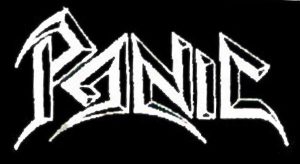 Soundgarden, Fifth Angel) we admired his tones and sought to attach our name to his. We saved our money and went into Steve Lawson Studios with him that summer and did four songs. It’s a beautiful demo and it was really the first time we’d heard ourselves properly recorded. After the Saturday night sessions, around midnight, we jumped the 8’ chainlink fence that surrounded the festival grounds of Seattle Center, where the famous Space Needle is. It was Labor Day weekend, when the city hosts its Bumbershoot festival. It’s a much bigger deal these days, and in the post-911 security culture of the US we probably would have been arrested if not shot. But this was 1987, and instead security just escorted us off the grounds. We were pretty full of ourselves that particular night…
Soundgarden, Fifth Angel) we admired his tones and sought to attach our name to his. We saved our money and went into Steve Lawson Studios with him that summer and did four songs. It’s a beautiful demo and it was really the first time we’d heard ourselves properly recorded. After the Saturday night sessions, around midnight, we jumped the 8’ chainlink fence that surrounded the festival grounds of Seattle Center, where the famous Space Needle is. It was Labor Day weekend, when the city hosts its Bumbershoot festival. It’s a much bigger deal these days, and in the post-911 security culture of the US we probably would have been arrested if not shot. But this was 1987, and instead security just escorted us off the grounds. We were pretty full of ourselves that particular night…
We worked this demo hard, sending it to radio stations, magazines and record labels. George had designed a killer logo and we took some photos on a stone staircase off Green Lake in Seattle. I pasted up some liner notes with lots of special thanks. The initial run of 100 cassette tapes was financed by a local record store manager named Lance Goodwin. Bubble Records was a great outlet for the latest in heavy metal, and Lance was a fan & friend. After exhausting our budget on studio time, we didn’t have enough money to pay for production!
The demo didn’t get us a record deal, but it did get the attention of Jeff Gilbert who at the time was still hosting his Brain Pain radio show on Sunday nights at the University of Washington’s KCMU radio station (now the commercially-popular KEXP). Jeff was very supportive of Panic and played the tape every week. Jeff Gilbert was definitely the first and most-important Seattle media to get behind Panic, and really helped us graduate from suburban booger pickers to downtown Seattle legitimacy in a very short time.
Late ‘80s Seattle
As you astutely point out, the late 1980s was the pre-grunge era in Seattle. It’s not as if that music hadn’t been invented yet, because Green River was certainly playing and recording as were Crisis Party, Catbutt, Malfunkshun and a bunch of other bands that would wear the grunge label later– after it was identified. The scene back then was more integrated– with the possible exception of metal. Metal is metal is metal—that has always been the case. People who don’t specifically like metal often go out of their way to avoid it; and by the same token metal fans often only consume metal shows and records. That said, Panic was always embraced to an extent by the unmetal community, and we billed up with lots of bands from outside our genre. It wasn’t a Thinking Man’s Metal shtick like BÖC—more like Drinking Man’s Metal…
I’m sorry to say it, but in those days there was quite a bit of self-aware competition between the bands in our class. Sanctuary, Queensryche and Metal Church had already graduated, of course– they had major label deals and tour support. Panic and Forced Entry and Bitter End were left to jockey for position and though there was much comradery (much of which endures to this day) there were also
“The Circus-Circus is what the whole hep world be
doing on Saturday night if the Nazis had won the war.”
Hunter Thompson, Fear & Loathing in Las Vegas– 1971
In a month when Steve Van Liew sang Overlord songs with Palooka and Udo Dirkschneider’s son backed him on drums, Michael Schenker knew he’d have to throw down to even make the winner’s bracket. And on a rainy night at the bejeweled Neptune Theater, Michael did indeed rise up and throw down hard.
This was the most-bizarre spectacle I’ve ever seen set to rock music. Nostalgia is king these days– everyone knows that. Any used up piece of spent jet trash 80s ‘metal’ band can make rent by getting at least a couple of originalish members together and booking a tour. Whether it’s a sad comment on the state of contemporary heavy music that we’d rather go see the remains of Judas Priest again let alone a Mother Love Bone tribute is a secondary issue. Let’s just say there’s always money in the banana stand.
But this was different. It wasn’t just a rock show. This was a high-stepping retrospective musical revue of the strangest order.
I didn’t know what to expect. Word was that all the main-era singers were going to be there, but I couldn’t imagine how it would be presented. The show was to begin at 8pm and there was no opener. Punctuality is very German. The houselights were hardly out when Michael stepped to the mic from the wings of stage left.
“I am Michael Schenker,” he proclaimed in his familiar accent. “Lead guitar! Welcome to Schenkerfest!”
Very direct. So German. He continued.
“On bass Chris Glen!” No Flight of the Bumblebee recorded intro. No scurrying roadies with penlights. No dry ice. He was going to introduce the band under plain white stage lights before ever playing a note. Like a recital.
“On drums Ted McKenna!” he continued, to wild applause from his loyal crowd. “On rhythm guitar and keyboards Steve Mann!”
And then without further posing or wording, he grasped the neck of his great ax.
“Into the Arena!”
And with that he was off and running. If Michael had known when writing this instrumental for his debut solo album in 1980 how powerful a set opener it would make nearly 40 years later, he wasn’t letting on. Instead there he was, grinning from his signature crouch, the wings of his Flying V straddling his right thigh, winding his way to the end of the opener before announcing Gary Barden.
Gary Fuckin’ Barden! One of my favorite pre-metal hard rock singers and by far my favorite of Michael’s solo partners. He strode out from stage right in pointy boots and 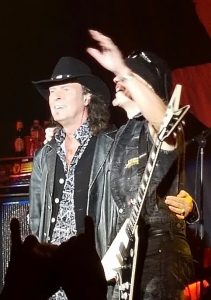 a gambler pulled down tight over his eyes to the opening strains of the gentle “Let Sleeping Dogs Lie.” My hopes were high, but my expectations realistic.
a gambler pulled down tight over his eyes to the opening strains of the gentle “Let Sleeping Dogs Lie.” My hopes were high, but my expectations realistic.
Very unfortunately, Barden’s voice was totally cindered. Whether it’s permanent or just a bad night is impossible to say from one show, of course– but his performance caused me to grab my own throat and gasp for breath. He muscled through four songs and did his best to appear relevant. But it was fairly painful to watch, and though I wouldn’t have thought it possible, I was actually relieved to see Michael throw his right arm around Barden’s shoulders, pose momentarily for the iphones, and dispatch him back to stage right before Chris Glen introduced “Captain Nemo.”
The instrumental served as a sorbet between singers, Michael alone at center stage effortlessly shredding as a god. And as Nemo reigned in, suddenly there was Graham Bonnet, all 70 years of him, emerging from the same wings into which Barden had disappeared–to the opening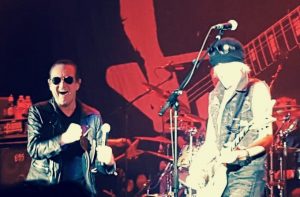 refrain of “Desert Song.”
refrain of “Desert Song.”
Graham Bonnet is a freak of fucking nature. I thought he was 70 when I saw him and his new sidekick Yngwie from the front row of the Paramount on the first Alcatrazz tour in probably ’83. That was a long time ago, but it appears to have been nothing more than an afternoon for the timeless Bonnet. He still looks like he always has—slicked back hair, dark aviators, leather jacket with the sleeves pushed up. But his voice is so powerful, he just sings so hard he shakes the theater. Fully amazing. His one album’s worth of songs with Michael are not my favorites, but Bonnet turned in a spirited performance and looked as comfortable in the role as any of the singers all night.
And after four songs, Michael threw his right arm around the shoulders of Graham Bonnet, posed for the photos, and dispatched him back into the black void where I pictured Gary Barden moving down one folding chair so Graham could sit down in the proper order.
Michael stepped to the mic.
“It has been 40 years since I recorded Love Drive with the Scorpions,” he explained, rather academically. “I wrote this song for my brother Rudolph and I gave it to him.”
Dig Michael the stage rapper. No how you people doin’ tonight?! No it’s great to be back in See-a-tal! No let me see your cigarette LIGHTERS!! Just the facts from Michael. Straight and to the point. Sleek and lean. He wrote “Coast to Coast” for his older brother, but he was going to play it for us right now.
Absolutely magical. The instrumentals woven into the set served a critical role in the construction of the evening—the engineering was magnificent. But to hear these gilded melodies coming live out of Michael Schenker’s guitar without any singer jockeying for favor was extra special. And I’m not a guitar player! Normally I need singing to be interested in music, but I found myself wishing my way through the verses to get to the solos and in particular enjoying the instrumentals.
And then of course, out pranced Robin McAuley.
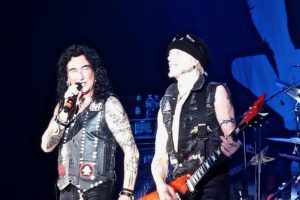 The mid-80s McAuley-Schenker period was an uninteresting one for me, and the songs of McAuley’s set re-enforced that. We all know what the mid-80s were about, and that was on-display in all its tinfoil glory with dangling chains and lots of Bedazzler during McAuley’s set. His voice was fine if you like that kind of dreck, but there’s something very untrustworthy about that cat if you ask me. He looks like a Realtor they plucked off the golf course and dressed in pleather and a black wig. A very thick veneer. His tattoos and biker patches don’t fool me– he’s not very heavy metal…
The mid-80s McAuley-Schenker period was an uninteresting one for me, and the songs of McAuley’s set re-enforced that. We all know what the mid-80s were about, and that was on-display in all its tinfoil glory with dangling chains and lots of Bedazzler during McAuley’s set. His voice was fine if you like that kind of dreck, but there’s something very untrustworthy about that cat if you ask me. He looks like a Realtor they plucked off the golf course and dressed in pleather and a black wig. A very thick veneer. His tattoos and biker patches don’t fool me– he’s not very heavy metal…
Lucky for me he was only up there for four songs before Michael threw his right arm around his shoulders and paused, smiling, before sending him back to henhouse where Barden & Bonnet both moved down a seat.
From there shit got weird.
To this point, things had seemed very linear: chronological singers performing the songs of their respective eras, broken up by tasty instrumentals between courses. But once McAuley was finished, it turned into a real floorshow. All three came out at once and proceeded to swap verses on some songs from the recently released Resurrection album. The Neptune stage is not huge, and with three singers posting up, things got a little crowded. The three MSG ‘frontmen’ shouldered up together, each doing their own period-appropriate dance moves and winking at the crowd & each other. With their own cordless microphones, they reminded me of the Beastie Boys, taking turns on verses. One would step forward while the other two would fill in behind. Then they’d all come together for an endless chorus before Michael ripped off a double solo and they had to comp even more time, working those dance steps and winking up a lather. As much as I admired the concept, the manifestation of it made me feel kind of funny deep inside. I couldn’t tell if they were more like the 3 Stooges, the Witches of Eastwick or the Golden Girls– each with their own distinct costume, accessories and, presumably– superpower.
And then as if matters couldn’t have been more awkward, out came something called Doogie White, apparently the current ‘lead’ singer. He took his shift on what were presumably songs from the new record, brandishing the Sign of Rock and Roll at the audience, paying his tribute to DIO which included a song for the Master called “Before the Devil Knows You’re Dead.” Doogie’s kicked around this circuit for a while, but I failed to see his value in this setup. His voice was strained and his antics tiresome. If they needed a fourth hand to round out the singer’s cribbage tournament, then alright. But by that time the focus on the stage was getting a little fuzzy and the block of new material fairly monotonous.
But through it all, there was Michael Schenker just doing his thing. Chris Glen was definitely driving the band, and Michael had no responsibilities whatsoever beyond 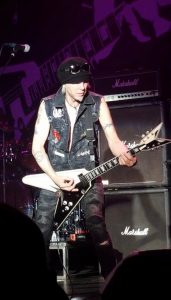 killing every single note and just being Michael. He’s really got that little crouching shuffle perfected, and he inches from one end of his sector to the other, just grinning up a storm– adorbs! Schenker’s personal problems of the 90s have been ponderously documented, but by all accounts he is clean and driven. He looks awesome in his uniform of (really) skinny jeans, patched vest and beanie w/ goggles. But it’s his playing that testifies to his clarity. The overall sound was pretty muddy, including Michael’s rhythm tone. But his solos were like drawn butter, sinfully rich and creamy.
killing every single note and just being Michael. He’s really got that little crouching shuffle perfected, and he inches from one end of his sector to the other, just grinning up a storm– adorbs! Schenker’s personal problems of the 90s have been ponderously documented, but by all accounts he is clean and driven. He looks awesome in his uniform of (really) skinny jeans, patched vest and beanie w/ goggles. But it’s his playing that testifies to his clarity. The overall sound was pretty muddy, including Michael’s rhythm tone. But his solos were like drawn butter, sinfully rich and creamy.
Michael is 63 years old, but he looks like he could do this forever. He played almost three hours without taking a breather. He’s an energy star, that’s for sure– not a wasted word or movement. Economy is the name of the game. No empty audience banter and not a solitary wasted movement. His right hand hardly moves at all while his left is like a tarantula effortlessly wandering the neck of his Flying V.
“Do you want to hear some more?” he asked at the end of the Resurrection set. Naturally, the crowd wanted to hear some more. There was no secret as to what most of us had come to hear…
And Michael didn’t hold back. We’d pumped our fists in the air to some mixed material for more than two hours now, and there was no reason not to reward us with the UFO songs we’d hoped for. I thought maybe he’d do “Doctor Doctor” and bow out, but I’ll be damned if he didn’t offer up five classics including the obligatory extended middle solo section of “Rock Bottom” which was other worldly. The place went nuts as the singers racked up verses, each seemingly vying for Michael’s favor. They really kind of reminded me of a bunch of ex-wives who discovered that they really enjoyed hanging out together.
I don’t know how long they’ll be able to keep that bus on the road, but I’m glad it made it as far as Seattle. It was a really big show…
PHOTOS by ROCKFISH!
Stop me if you’ve heard this one before.
I had a dream last night that starred my friend Soozy. We were sitting at a round table, outside. Patti & Evan were there, which made sense. Even George’s wife Sue wasn’t completely out-of-place. But the fact that Diana was there was a clear sign from my subconscious that this was indeed a dream and not a half-memory or some pre-sleep notion. Weird how our subconscious minds play those little practical jokes on us…
I don’t remember anything else about the dream except that we were all in real-time (our current ages) except for Soozy who was represented as a younger version of herself—the version I first came to know in the very early 1990s.
We met in Seattle. I was the singer in a heavy metal band and she was freelancing variously in management & booking, freshly graduated from the Art Institute. Soozy is a highly-intuitive person, and has always had a 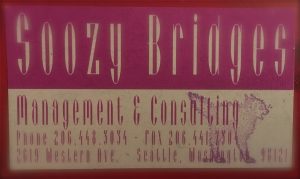 very keen ear for talent—talent that isn’t always apparent to everyone else. As a result, she would often take on projects. Considering the nature of the inventory, many of these projects were tortured & unreliable at best. Deeply talented, sure– there may even have been a bonafide genius or two in the flock. At their worst, however, they were startlingly self-destructive. Some of us made it through. Others didn’t.
very keen ear for talent—talent that isn’t always apparent to everyone else. As a result, she would often take on projects. Considering the nature of the inventory, many of these projects were tortured & unreliable at best. Deeply talented, sure– there may even have been a bonafide genius or two in the flock. At their worst, however, they were startlingly self-destructive. Some of us made it through. Others didn’t.
Soozy was fifteen years older than us back then. To be clear, she’s still fifteen years older than we are. At the time, though, in our mid-20s, the fifteen years seemed more significant than now. Among Soozy’s favorite roles was that of spiritual mentor. Some of us were more skilled than others at absorbing the less-linear elements of her coaching– but in the end much of what she was doing was herding cats. We actually were quite a bit like kittens or puppies in those days– clumsy & playful: mischievous yet adorable. We often fell down in big piles, rolling around on the floor panting and drooling, unable to get up. Soozy might have wished we weren’t such a complete collective mess all the time, but she loved us anyway and saw in each of us a superpower that in many instances we ourselves had no inkling we possessed. I often said Soozy was like a rock and roll den mother. She liked to party at night, but perhaps her greatest gift was recovery. I’m not talking about longterm recovery; but rather the daily kind.
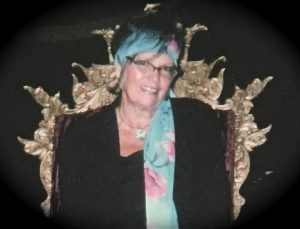 “Take these,” she’d say, “and drink two beers as fast as you can.” And though a beer might not have been exactly what you’d had in-mind right then, I’ll be damned if by the middle of the second one you weren’t feeling pretty much better and actually considering a third.
“Take these,” she’d say, “and drink two beers as fast as you can.” And though a beer might not have been exactly what you’d had in-mind right then, I’ll be damned if by the middle of the second one you weren’t feeling pretty much better and actually considering a third.
I still didn’t know Soozy that well when we found ourselves in California in the summer of 1993 trying to promote Panic’s largely unpromotable second record. We had squandered a better previous record deal and a much more muscular previous management deal, and Soozy was doing what she could to keep the band afloat. But it was getting late and it was clear that the ship was taking on water. I remember getting on a plane the morning after the last show of that shameful California tour– while the rest of the band was still asleep in heaps on the floor at the Phoenix Hotel in the Tenderloin– knowing in my heart that the bitchin’ disaster we’d been humping furiously for most of the previous ten years was winding down.
My Mom picked me up at the airport in Little Rock and drove me back to her & her husband’s house in Hot Springs where I fell asleep on the couch watching the Allstar Game. In the morning, I got to work picking the weeds out of the cracks in the driveway with a screwdriver. It was 102 degrees and 97% humidity, but this job had to be done because the house was going on the market the following week. I finished the driveway and a few other tasks in-time for my mom to take me back to the airport to catch a short flight to Norfolk where I served as Best Man in a high school friend’s wedding (jumping into the fountain in a rented tuxedo w/ the marriage certificate in back pocket). My only other friend from high school (coincidentally not friends with the newlywed friend) picked me up the next day and we drove to Washington DC where we saw the last song of the Sister Double Happiness set at the Bayou in Georgetown. We didn’t even know they’d be playing—we were just hanging out at the Bayou! We then stole a half-night’s sleep at the Ramada before catching a train into Manhattan where we walked around the Village rationing what little money we had left. We caught a late train back to DC, got in the car, and drove without sleeping to friend’s house in Eastern Tennessee where we did sleep. After a few days, Andy put me on a midnight Greyhound across Tennessee and Arkansas, back to Hot Springs where by this time Mom & Art had moved into their new house. This house had a beautiful, cylindrical copper fireplace in the middle of the living room, like a Lyon’s Restaurant. It also had a smooth, modern driveway. So instead of soul-smashing driveway torture labor, we tooled around Lake Hamilton in their party barge drinking bourbon and pretending to fish for bass. After a few days, Mom took me back to the Little Rock airport. I flew back to Seattle and we broke up the band.
The afternoon before fleeing California, though, was a beautiful summer San Franciscan day. I’d had something else to do that afternoon, and the plan was for me to meet the band at soundcheck. I arrived in a red minivan, rented to the band (probably on Soozy’s credit card). We were playing at the historic I-Beam on Haight Street. It wasn’t called the I-Beam at the 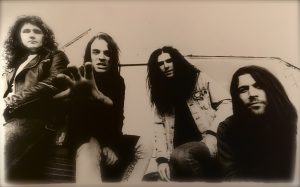 time, but it was the same room. I knew immediately upon walking in the door that something was not right. The club wasn’t open yet, and there was no house music playing. The only noise came from the sound crew setting up mic stands and the bar staff filling the ice bins in preparation for the evening. Normally, I’d walk into a setting like this to find the band & crew crowded in a booth laughing and smoking and killing a pitcher. But today, everyone was scattered in different corners of the club. George was slumped in a corner booth, his back to the stage. Jack was upstairs losing a game of pool to himself. Pinky was curled up in the fetal position on a roadcase backstage. And Marty was tucked up onto a high shelf above a coatrack in a service corridor between the kitchen and bar, sound asleep. I found Soozy.
time, but it was the same room. I knew immediately upon walking in the door that something was not right. The club wasn’t open yet, and there was no house music playing. The only noise came from the sound crew setting up mic stands and the bar staff filling the ice bins in preparation for the evening. Normally, I’d walk into a setting like this to find the band & crew crowded in a booth laughing and smoking and killing a pitcher. But today, everyone was scattered in different corners of the club. George was slumped in a corner booth, his back to the stage. Jack was upstairs losing a game of pool to himself. Pinky was curled up in the fetal position on a roadcase backstage. And Marty was tucked up onto a high shelf above a coatrack in a service corridor between the kitchen and bar, sound asleep. I found Soozy.
“Um,” I said, tentatively. “What’s going on?”
“Shhhh!” she hissed, looking around as if someone were listening. “They’re on the cookie!
Soozy had been promising this experience the whole time we’d been in California, though it had largely fallen on ringing, deaf ears. Soozy was our mentor; and she in-turn had her own mentor—also the source of the mythical cookie. Sheila Rene was a publicist by trade, but definitely a
Groundhog Day. Shit, I almost forgot about that.
As if every day isn’t already so impossibly like the last. As if pasty whites in ill-fitting clothes and bad hair don’t already have too much to say. As if we need another six weeks of this nonsense, let alone four years.
Groundhog Day. That’s all we need right now…
No one really understands Groundhog Day, and I don’t see any good reason to start now. Yes, of course everyone knows that on February 2, an anointed Groundhog somewhere on the east coast emerges from his or her den and if he/she sees its shadow, then there’s six more weeks of winter. This much we all ‘know’ the same way we ‘learned’ the Gettysburg Address and the Preamble.
But—you know—what does it mean?
First of all, what even is a groundhog? I doubt most people not from Punxsutawney, Pennsylvania could tell one apart from a Prarie Dog, Hedgehog or a common rat’sass Gopher. And why Punxsutawney (pronounced Punxsutawney) anyway? How did it come to pass that a stillwater no-doc ‘town’ of 6,000 in the middle of Pennsylvania (read: nowhere) got to be in-charge of the weather? After all, spring is important! There’s a lot of fucking that goes on in spring that’s of genuinely high consequence. Delaying or accelerating its arrival could mess with the natural rhythm of the season and throw us into a chaos we 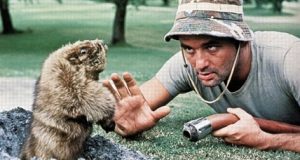 haven’t seen since December 2000. I’m saying now that there’ll be heck to pay come June if there’s no kittens to euthanize or if the clematis doesn’t bloom by Father’s Day. Merely sayin’.
haven’t seen since December 2000. I’m saying now that there’ll be heck to pay come June if there’s no kittens to euthanize or if the clematis doesn’t bloom by Father’s Day. Merely sayin’.
I’ve researched it and still don’t hardly understand it. Near as I can tell, the six-week swing was a compromise between the Germans and the Scots because they favored different equinoxes– the Vernal or the Imbolc. So someone suggested they let a rodent decide. It is no less simpleheaded than a cointoss, but more civilized than a bloody Dark Ages war, when you think about it. Plus we got a good movie out of it, so at least we got that goin’ for us. Gunga la Gunga…
The calendar. The seasons. The Court. What’s any of it matter? March. Put a candle in the window at 7pm. Leave a voicemail for your legislator. The monied Christians are going to do what they’ve always done– what they want. It’s the year 2017. Does that mean the world has only been alive for 2017 years? Of course not! It just means that the Christians set the clock like they set everything else. Everyone plays by this rule, even the majority of the world that doesn’t believe in Jesus. It’s 2017– it’s not worth disputing. Can’t hardly blame folks for picking a battle.
So we’ll see what Punxsutawney Phil says tomorrow. I’m told he’s a hell of a Groundhog. Tremendous Groundhog.
July 4, 1976. Our nation’s bicentennial. On the shoulder of I5, signing a speeding ticket. This is my first memory of living in Washington State.
My stepfather was in a hurry to get to Federal Way before dark and was pressing a bit outside Centralia. This was the first moment of the 2nd stage of my life.
It was dark by the time we got to our new house, but I still knew our new neighborhood was different than the one we’d left day before yesterday. Though I could not see it, I knew it was different. It sounded different. It smelled different. It was only 800 miles geographically removed, but it felt like a different world altogether.
It was different. We were rich!
What other explanation was there? On July 2nd, we’d left the only neighborhood we’d ever known – a narrow grid of greasy streets literally on the wrong side of the BNSF tracks, sandwiched between the Bayshore Freeway and San Francisco International. The view from my 2nd floor bedroom of the 2+ bedroom 1-bath postwar bungalow I shared with my mother & sister was of the UNITED AIRLINES sign at SFO. The jets roared up and down the terminal night and day as did the trains on the tracks and the cars on the freeway. All night and day.
And then (almost) literally overnight, we were reborn. There was no fence in the new yard—only a giant hedge ( Stepfather proudly told us it was called Rhodonendron ) and a cropped green lawn stretching as far as the eye could see. Like the streets, the yards twisted in impossible angles with wide sidewalks and curbs baring such ridiculous addresses as 33519 327th Court SW. This was our address, after coming from 527 4th Avenue. How the fuck were were supposed to find our way around? There were no telephone poles…
My sister and I didn’t know what was going on. Our previous neighborhood was 70% Mexican, but everyone on our new street was white. Still, they all played soccer. No one in our old neighborhood played soccer! All the houses had garages, so there were no cars parked on the street. There were airplanes, but they seemed far up in the sky. We didn’t know where the closest store was.
We understood the bicentennial was a big deal. We’d heard about it on TV and they’d made a special 25-cent piece for it at the mint. There was a lot of flag waving at a time when flag waving wasn’t an every-day passtime, not like today. These days you have to wave a flag so people don’t think you’re a socialist. This was the mid-1970s…